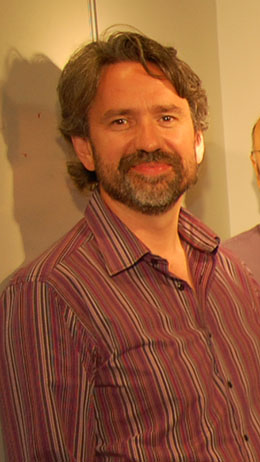Where memories go
A leading dementia expert at the University of St Andrews has been praised for helping broadcaster Sally Magnusson better understand the disease that gripped her mother.
The award-winning journalist sought the advice of Professor Frank Gunn-Moore when researching her new book Where Memories Go. Why dementia changes everything.
She describes Professor Gunn-Moore’s expert help in teaching her about the science of dementia as ‘an important part’ of the book, in which she examines the loss of her late mother Mamie to the disease.
So insightful was her time at St Andrews, she ended up naming the book after something the researcher said to her during a tour of his lab.
The meeting, documented in chapter 3 of the new book, was part of Sally’s attempt to better understand the disease she describes as ‘the scourge of the 21st century’.

Sally Magnusson, copyright Derek Prescott. Professor Gunn-Moore.
She writes: ‘You ask me what memory is,’ he (Professor Gunn-Moore) says to my bent head. ‘Well, it can be defined in many ways, but for me that’s it there. Right there. You’re looking at the place where memories go.’
The resulting book, Where Memories Go, is described by the author as ‘the biggest story of my life’.
Professor Gunn-Moore is Professor of Molecular Neurobiology and Director of Research at the University’s School of Biology. His work, funded by Alzheimer’s Research UK and the Alzheimer’s Society, has led to the development of a prototype compound known to reverse signs of the disease.
Professor Gunn-Moore, who is also Chair of the Alzheimer’s Research UK network for Scotland East Coast Central, said, “It was a great pleasure to help in this wonderful book.
Sally came to our labs here in St Andrews and discussed various aspects about dementia, the scale of the problem and what is currently being done about it from a scientific point of view. She was fascinated when we showed her living nerve cells growing in a petri dish.
“I particularly liked her analogy in which she described them as Christmas lights, and that in dementia these were the lights that were being turned off in her mother. Indeed she asked me what a memory was. I explained that, to me, where the nerve cells connect with each other is what a memory was. This obviously meant a lot to her as she described this as “where memories go”, the title of her book.
“Meeting people who have been closely affected by dementia is always a humbling experience as it always gives a great sense of purpose to the work that my team is doing.”
ENDS
NOTES TO EDITORS:
Professor Gunn-Moore is available for interview on 01334 463525
Issued by the Press Office, University of St Andrews
Contact Gayle Cook, Senior Communications Manager on 01334 467227 or email [email protected]
Ref: Sally 190214
Category Research